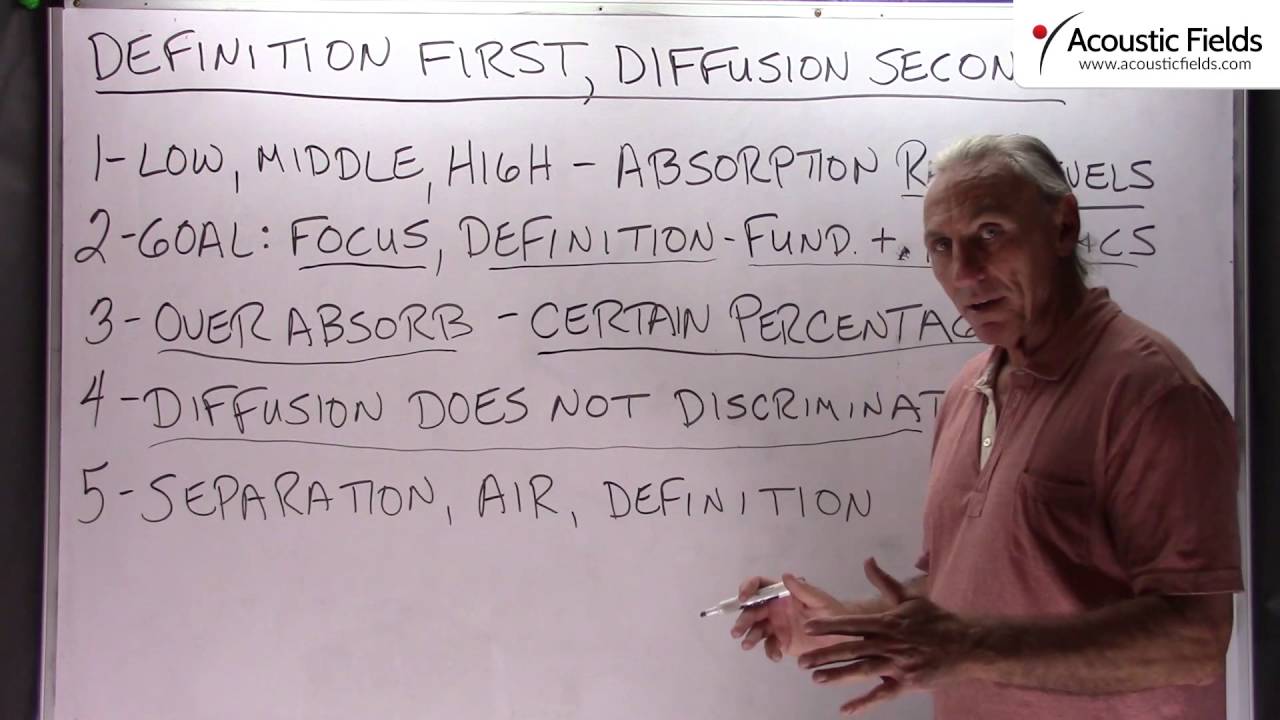Today we’re going to talk about diffusion. There seems to be a lot of misunderstanding out there about it. It’s a shame really because diffusion is such a great tool, especially in 2 channel playback, control rooms, mixing rooms, rear wall situations, ceilings in home theaters, rear walls in home theaters. It really adds a lot to the presentation.
So I want to walk through a few basic rules today with it and maybe we’ll do some other videos to illustrate the power of this technology. If you go on our website you can see some of the comments in the DIY section about people who have used diffusion and can’t believe it. You know, the terms they use are magical, unbelievable. And if you’ve never experienced diffusion you really owe it to yourself because it’s kind of the last undiscovered frontier if you will in acoustics.
But let’s look at a little bit about how it all works. You know, from our videos you know that we use quadratic diffusion. It’s predictable and consistent plus it has a frequency response. So these tools make it easy to use in situations so it’s commercially viable.
So what do we have to do here when we’re dealing with diffusion? We have to get our low, we have to get our middle, we have to get our high frequencies defined and in place through the use of absorption. Now, not just any absorption, we have to use the proper rates and levels of absorption and I’ve done numerous videos on this subject. Using a material because it sounds absorptive usually isn’t the right thing to do if you don’t know the rates and levels, especially when you’re dealing with music and voice. Music and voice are very special. If you’re dealing with noise, that’s a different issue but music and voice the rates and levels have to be of a certain rate and at a certain level. So you need to be careful with these generalities.
So our goal is to achieve a focus and a definition with both fundamentals and harmonics. And you can do this through absorption. You have to be a little careful with the harmonics because if you get too much absorption going after the fundamental frequency then you impact the harmonic obviously. So you have to be a little careful there. But you choose a technology, sound absorption technology with the right rate and level, you won’t have that problem, okay?
And it’s okay to over-absorb a little bit when you’re dealing with diffusion. And we’ll go into the reasons for this later. But it’s good to get a certain percentage of over-absorption, especially in the middle and high frequencies because when you add diffusion, diffusion does not discriminate. What does that mean? That means whatever you give it, if it’s muddled, if it’s fuzzy, if it’s unclear, it’s not defined then it’ll give it to you right back.
So you want to make sure you know, the old saying with computers years ago, garbage in, garbage out; we don’t have that anymore because they’re all garbage. But anyway, the bottom line here is diffusion does not discriminate.
So you want to make sure that you get your definition first before the reflected energy goes into the diffuser and then you bring it back and it’s much more open, much more airy, much more separated and much more defined so you get yourself a really nice presentation whether it’s recording or playback. And that’s the beautiful thing about diffusion.
So just remember that we have to define our fundamentals and our harmonics first before we then deal with the reflections from the diffuser. And remember, a diffuser is like a speaker. You don’t plug it in, it’s not an active device but you do feed it energy and it feeds energy back. I hope this helps a little bit. We’ll do some other videos on diffusion but this is a very powerful tool, you should definitely use it in your presentations or your work.
—
This is an unedited transcript from our video series from Acoustic Fields. There will be some errors in grammar and sentence structure that occur during this translation process.
For complete understanding and comprehension, please view the video which is included in this text. For any additional information regarding this topic or others relating to room acoustics, please contact us directly at:
P: 520 – 392 – 9486








Dear Mr. Foley,
I have seen some very interesting videos from Acustic Fields
I am working on ” Innovations “, especially on ” ECOOO-WALL HIABS ( High Absorbing “.
( A Green Noise Abtement Wall Using Waste Materials ).
Do you have experiences in the field of Noise Abatement Systems along Highways?
If yes, we should find a way for a succesfull cooperation.
Best Regards
DI Dr. Wolfgang Lederbauer
Wirtschaftsingenieur Bauwesen
A 1010 Wien
Dominikanerbastei 6
Tel: 0664 954 52 54
e mail: wolfgang.lederbauer@chello.at
Hi Dr. Lederbauer,
We are a small to medium size room acoustic treatment company that focuses on voice and music. Our experience with outside barrier technology is limited.
Soundfighter is a company that has numerous installations in the Phoenix / California markets. I see their technology represented along many new highways in these two states.
https://www.soundfighter.com/applications/roads-and-highways/